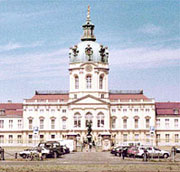Castles and Palaces in Berlin
The only direct evidence of Berlin's medieval fortifications
and custom wall lies in the word "Tor" or "gate" in many of the
place names in the city centre. The city was originally surrounded
by a wall and moat, to protect the inhabitants from marauding
German knights as well as to control the passage of goods and
persons who travelled through. These walls were knocked down and
rebuilt many times in the Middle Ages as the city expanded, and
only a few traces of them remain to be seen in the centre. A few
miles to the north-west, however, on the river Havel, lies Spandau's
Zitadelle fortress and the Juliusturm, built in the 12th Century
by the Askanien dynasty to complement a second fortification at
Köpernick, and control trade across Brandenburg. Spandau remained
a fortress through the 16th C. when Venetian style bastions were
added into the 20th C. , when it was 'defortified' and integrated
into the city.
 Nearer
the centre Schloss Charlottenburg, the baroque summer palace of
the Hohenzollern dynasty and resting place of the first German
Emperor, Kaiser Wilhelm I and his wife in the nearby Mausoleum,
is open to a public eager to see its collections of paintings,
furniture and porcelain. The lawns and flowerbeds of the landscaped
grounds to the rear run down to the river Spree, whilst a statue
of the Great Elector by Schlüter dominates the forecourt underneath
the copper cupola. Nearer
the centre Schloss Charlottenburg, the baroque summer palace of
the Hohenzollern dynasty and resting place of the first German
Emperor, Kaiser Wilhelm I and his wife in the nearby Mausoleum,
is open to a public eager to see its collections of paintings,
furniture and porcelain. The lawns and flowerbeds of the landscaped
grounds to the rear run down to the river Spree, whilst a statue
of the Great Elector by Schlüter dominates the forecourt underneath
the copper cupola.
Wanting to reside close to the political centre of gravity, many
wealthy Prussians built their own stately homes in the outer suburbs
of Berlin, stately neo-classical edifices richly decorated tapestries,
marble, antique furniture and carpets.
Amongst the most celebrated are Schloss Tegel, family home of
the Humboldts, the two brothers, the academics Alexander and Wilhelm
who founded the University. Schloss Tegel looks out over Tegeler
Lake. on the northern Havel. The palace of Niederschönhausen was
the residence of Wilhelm Pieck, first President of East Germany,
and sports a fine marbled gallery.
A more visible building is Schloss Bellevue, seat of the German
President, which is located in the Tiergarten, near the Reichstag.
It has an English garden and is built on a piece of land where
mulberry bushes for silkworms were cultivated.
But undoubtedly the most famous palace of all is Sanssouci -
Frederick the Great's legendary retreat in Potsdam, 15 miles south-west
of the Berlin's city center. Under the Hohenzollern dynasty Potsdam
had already become a royal residence and garrison town, but it
blossomed in particular in the mid 18th C. when Frederick commissioned
the architect Knobelsdorff to build a palace where he could live
"sans souci" - "without care". The French name as well as the
style of the palace reflects Frederick's enormous admiration for
Louis XIV of France and Versailles. The palace stands at the edge
of Park Sanssouci, a landscaped pleasure park stretching 1 by
1.5 miles, to the west of Potsdam. The Schloß is in the highly
ornate rococo style, with marble floors, painted woodwork, oriental
wallpapers, and a vast collection of portraits, all arranged in
a confusion of colour and pattern.
To the south, a number of terraces with the most northerly vineyards
in Europe run down to the main level of the park. This contains
a number of further palaces added over the following 150 years
for other Hohenzollern relations, including the Neues Palais (New
Palace) and the Charlottenhof (a villa celebrating a Hohenzollern
princess). The park is also ornamented with an Orangerie, a Dutch
garden, the Neptune fountain, a folly, a windmill, fake Roman
baths and a wealth of statues.
Schloss Sanssouci itself is open daily from 9 to 5 (April-Oct),
9-4 (Nov-March), apart from Mondays, and can only be visited as
part of a guided tour. English language tours can be arranged
in advance, but notice is needed because the Schloß is a very
popular tourist attraction.
See
list of castles and palaces in and near Berlin.
Learn more about Potsdam and its castles
and palaces.
© 2002-2003 Berlin Travel Service - A1 Design All rights reserved.
|